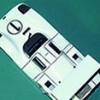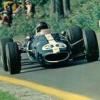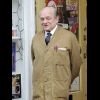
First team-owned wind tunnel?
#1

Posted 06 January 2009 - 09:44
today it seems normal that the huge teams have their own wind tunnels. But when did it happen first? When did the design of a F1 car begin to be based on hard engineering data rather than the 'instinct' of the designer? When were wind tunnels first used in F1 (by renting an wind tunnel), and which team was it? And which team did build their own tunnel first?
Thanks a lot in advance!
a.
Advertisement
#2

Posted 06 January 2009 - 09:50
DCN
#3

Posted 06 January 2009 - 09:57
1960 is really much earlier than I appreciated. I guess it was the engineers' 'philosophy' of looking for optimized drag rather than downforce that held back the F1 aero revolution for almost a decade then.
Tells us that the best technical gadget isn't of any use if you don't know what to do with it!
And do you know when using a wind-tunnel became standard practice? I always had the impression that most of the 68/69 aero configurations were rather intuitive than scientifically deduced. But maybe my point of view is anachronistic, given that the aerodynamics of the 1990's as well seem rudimentary compared to today's cars.
a.
#4

Posted 06 January 2009 - 10:30
#5

Posted 06 January 2009 - 10:44
#6

Posted 06 January 2009 - 11:17
http://www.classicca...php/carno/40596
It states that
In 1954 Connaught entered F1 with the B type. Using a specially commissioned 2.5 litre Alta engine, and with a fully streamlined body (it was the first F1 team to have its own wind tunnel).
What about that?
#7

Posted 06 January 2009 - 14:21
DCN
#8

Posted 06 January 2009 - 15:21
#9

Posted 06 January 2009 - 15:35
#10

Posted 06 January 2009 - 17:53
When I was an apprentice at the Royal Aircraft Establishment in Farnborough, I remember seeing
photographs of D-Type Jaguars being tested in the 24ft wind tunnel.
For those of you that know Farnborough this is the grey building with the clock tower still
standing on the old RAE site.
#11

Posted 06 January 2009 - 20:05
Fascinating! I live there and never knew that.Originally posted by eglf
Hi,
When I was an apprentice at the Royal Aircraft Establishment in Farnborough, I remember seeing
photographs of D-Type Jaguars being tested in the 24ft wind tunnel.
For those of you that know Farnborough this is the grey building with the clock tower still
standing on the old RAE site.
#12

Posted 06 January 2009 - 20:15
Originally posted by byrkus
IIRC, Auto Union used wind tunnels for their LSR project in 1937/38. It would be logical that Mercedes would do the same at same time, and after their 'comeback' in 1954 (with streamliners!) only continue with wind tunnels. Then again, I do not know whether those wind tunnels were team or factory owned. But I think it would make sense.
No , I'm pretty sure the windkanals where the teams did their testing were at the Aerodynamischen Versuchsanstalt , which I believe was owned by Ludwig Prandtl .
#13

Posted 06 January 2009 - 20:30
Johnny Johnson, in "To Draw a Long Line", tells us that they had aerodynamic assistance from one Eric Hall.Originally posted by Doug Nye
I'm sure Connaught must have tried wind tunnel work but with whom I'm not sure - both Rodney Clarke and Mike Oliver (yes, the real Mike Oliver...) were ex-RAF pilot/engineers and knew a thing or three... No time at the mo to resort to the shelves and read it up.
DCN
They tested a scale model in the wind tunnel at Kingston Tech at the same time as they were testing the first B type at Silverstone. He quotes a w/t result that predicted a lift of 112 lb at 200 m.p.h. - as that was about the weight of the complete body with undertray and he didn't reckon they'd reach that speed, he seems not to have worried about it . . .
#14

Posted 06 January 2009 - 20:42
Wind tunnels
Aerodynamic Engine Covers
Briggs Cunningham edition Cadillac
Merecedes-Benz W196
Wind [article by Mike Lawrence]
And a few quotes:
Originally posted by Roger Clark
Denis Jenkinson, comparing the W196 and the streamlined Connaught:
"The Mercedes-Benz was not so strictly functional in its lines, pandering in small ways to the styling department, the publicity department and to practical knowledge as regards racing cars. Whereas the front of the Connaught would have done justice to a fighter plane, the Mercedes-Benz was styled to have a similar appearance to their production sports car. The Connaught made no concessions to the requirements of the tyres, demanding that the tyre manufacturers should be capable of producing a tyre that would stand up to the of racing without having the benefit of the outside air to cool the rubber. Mercedes-Benz, on the other hand, were prepared to upset the airflow along the bodywork and cut large holes in front of the rear tyres to allow some cooling air to enter the body. In a similar way they had air scooops for taking cold air into the cockpit, and other holes for letting hold air out of the engine compartment and for the exhaust pipes to protude through."
When the W196 was tested at Reims before its debut, it had a chrome three pointed star in the radiator intake. Tese were removed for the race, but reappeared at the British Grand Prix.
Originally posted by Roger Clark
Karl Ludvigsen, in "The Mercedes Benz Racing Cars" says "The nearby FKFS (Research Institute for Motoring and Vehicle Engines) was used for test of a one-fifth model of the proposed shape", and later "No wind tunnel tests of the full-sized body had been made before the day early in March 1954" (for the first tests of the car).
He later says that at Monza in 1954 coasting tests were done to calculate the aerodynamic efficiency of the bodies. I can find no further mention of wind tunnel work.
The results of the Monza tests were:
Open wheeled body: Frontal area 11.7 sq ft, coefficient of drag 0.62
Streamliner: Frontal area 13.4 sq ft, coefficient of drag 0.43
Originally published in Mercedes W196 article on ddavid.com site
Initial tests of the proposed [Mercedes W196] bodywork had been conducted using a 1:5 scale wooden model using the wind tunnel at the Motor Research Institute of the Stuttgart Technical College.
Originally posted by Holger Merten
Auto Union and Mercedes Benz used windtunnels in the 30s too. The first test I found for Auto Union in the windtunnel of Friedrichshafen was held in 1933 with a 1:1 scale modell....
Originally posted by Barry Lake
In early 1963, when Ford was trying to buy Ferrari, the latter had a rudimentary "wind tunnel", which was basically a big blower driven by a Ferrari engine. According to Franco Gozzi in his book "...Ferrari's Lieutenant", the contingent of Ford people who went to Maranello thought it was hilarious when Ferrari proudly showed it to them. There is a photo of the fan and shroud in the book.
#15

Posted 06 January 2009 - 21:26
Originally posted by AAA-Eagle
quote:Originally posted by Roger Clark
Karl Ludvigsen, in "The Mercedes Benz Racing Cars" says "The nearby FKFS (Research Institute for Motoring and Vehicle Engines) was used for test of a one-fifth model of the proposed shape", and later "No wind tunnel tests of the full-sized body had been made before the day early in March 1954" (for the first tests of the car).
He later says that at Monza in 1954 coasting tests were done to calculate the aerodynamic efficiency of the bodies. I can find no further mention of wind tunnel work.
The results of the Monza tests were:
Open wheeled body: Frontal area 11.7 sq ft, coefficient of drag 0.62
Streamliner: Frontal area 13.4 sq ft, coefficient of drag 0.43
Coasting tests are fine for the amateur, but really not much cop for professionals!
Unless you have a dead calm day (and how can you be really sure it is?) you need to measure air speed and ground speed and also to allow for any cross-wind component of the wind.
The other thing to comment on is that as road vehicle work (and missiles) bases the non-dimensional Cd on frontal area, what looks like a drag reduction for the streamliner of 30% is in fact only 20% - you need to use the "semi-dimensional" concept of Drag Area (= Cd × frontal area) to get the drag comparison.
#16

Posted 06 January 2009 - 21:39
Originally posted by Doug Nye
Curiously enough - considering how backward they were in so many ways - Ferrari built a scale-model wind tunnel under Carlo Chiti's direction as early as 1960, employing redundant 4-cylinder racing engines to power the fan. Other works teams had employed consultancy advice for many years using university and institutional tunnels, as distinct from investing in their own. I have a feeling there's another 'in-house' tunnel which predates Ferrari's but I can't retrieve it (honest!). Famously, aerodynamicist Frank Costin - perhaps the leading practitioner during the 1950s - preferred mathematical methodology to "messing about in wind tunnels".
DCN
I once read where , and it wasn't "in house" actually , but on the ACC 815 , Felice Anderloni used a 1/10th scale model in a windtunnel to finalize the body design back in 1940 . He also taped strips of felt to the car and drove it around snapping photos .
#17

Posted 07 January 2009 - 13:38
#18

Posted 07 January 2009 - 14:05
#19

Posted 07 January 2009 - 19:41
Err - does anyone recall that feeling?
DCN
Advertisement
#20

Posted 07 January 2009 - 19:58
Paul M
#21

Posted 18 February 2009 - 02:32
DRW
#22

Posted 18 February 2009 - 08:17
(a) post 13 - Connaught used Kingston Tech.Originally posted by racingreen
Was the British Aircraft Corporation tunnel owned by Bristol at one time? I had heard that Bristol had a wind tunnel. Did Connaughts and others use that?
DRW
(b) Not sure what you mean, but the Bristol Aeroplane Co. became part of the British Aircraft Corporation (BAC), so a Wind tunnel owned by BAC would of course have formerly been Bristol Aeroplane Co. property.
#23

Posted 18 February 2009 - 13:05
#24

Posted 18 February 2009 - 13:08
#25

Posted 18 February 2009 - 13:33
Wind tunnel, yes, but not team-owned by any stretch of the imagination!Originally posted by cpbell
I'm slightly more confident that the 1932 Indianapolis "Catfish Special" as driven by the entertainingly-named "Stubby" Stubblefield saw the inside of a tunnel, or at least would have been subjected to cotton-wool tuft analysis.
OT, but an (interesting?) bit of trivia: "Stubby" Stubblefield was only the substitute driver for the injured and not-substantially-less-entertainingly-named "Babe" Stapp!
#26

Posted 18 February 2009 - 15:39
Originally posted by fines
Wind tunnel, yes, but not team-owned by any stretch of the imagination!
Sorry, yes, fair point!
#27

Posted 15 September 2010 - 20:13
So what was the first Ferrari that benefited from wind tunnel testing? Was it the Sharknose?
#28

Posted 15 September 2010 - 21:16
Curiously enough - considering how backward they were in so many ways - Ferrari built a scale-model wind tunnel under Carlo Chiti's direction as early as 1960, employing redundant 4-cylinder racing engines to power the fan. Other works teams had employed consultancy advice for many years using university and institutional tunnels, as distinct from investing in their own. I have a feeling there's another 'in-house' tunnel which predates Ferrari's but I can't retrieve it (honest!). Famously, aerodynamicist Frank Costin - perhaps the leading practitioner during the 1950s - preferred mathematical methodology to "messing about in wind tunnels".
DCN
Moto Guzzi built their own wind tunnel at Mandello del Lario in 1953, to develop fairing design on their racing motorcycles. Full-size it was, not models!
Edited by larryd, 15 September 2010 - 21:17.
#29

Posted 16 September 2010 - 17:25
Famously, aerodynamicist Frank Costin - perhaps the leading practitioner during the 1950s - preferred mathematical methodology to "messing about in wind tunnels".
I remember seeing a photo of the prototype Lotus VIII with a tall flimsy mast with multiple pitot heads mounted all the way up it.
#30

Posted 22 September 2010 - 23:56
http://www.wrightfly...l/testing1.html
#31

Posted 23 September 2010 - 15:16
Moto Guzzi built their own wind tunnel at Mandello del Lario in 1953, to develop fairing design on their racing motorcycles. Full-size it was, not models!
From Vic Willoughby's The Racing Motorcycle:
Now used by top-flight skiers and bob-sleigh teams, the Moto Guzzi wind tunnel near Lake Como permitted full-scale tests of machines and riders. A large ring of lights facing him indicated wind drag to the rider and so enabled him to determine the fastest riding position.
Fascinatingly, the wind tunnel was used as much as a rider training device as to 'train' their designers. Given how the proliferation of team-owned wind tunnels has become a main plank of the 'cartelisation' of F1, Moto Guzzi's experiments with the same are pretty interesting. Trying to match the phenomenal straight-line speed possible with the 'dustbin' fairings, the private Nortons resorted to much cruder bits of metal without controlled aerodynamic testing. Their terrifying vulnerability to a sudden gust of wind, and the financial impossibility for these entrants to build a safer alternative, led to the FIM banning full-body fairings for 1956...




















